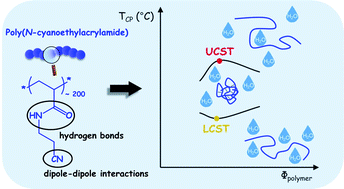Poly(N-cyanoethylacrylamide), a new thermoresponsive homopolymer presenting both LCST and UCST behavior in water†
Abstract
We have recently demonstrated that poly(N-cyanomethylacrylamide) (PCMAm) synthesized by reversible addition–fragmentation chain transfer (RAFT) radical polymerization exhibits a typical upper critical solution temperature (UCST)-type transition in water with a very small hysteresis between cooling and heating steps, and that the cloud point (TCP) of PCMAm is strongly molar mass dependent. In this research article, we have extended the study of the N-cyanoalkylacrylamide family by studying for the first time the RAFT polymerization of N-cyanoethylacrylamide (CEAm), which differs from CMAm by the presence of a second methylene group between the amide and cyano functional groups. Thereby, novel thermoresponsive homopolymers of CEAm displaying either a lower critical solution temperature (LCST) or both a LCST and an UCST (with LCST < UCST) in pure water were obtained. Interestingly, the transitions were sharp and reversible with low hysteresis. The investigation of PCEAm with a DPn ∼ 200 at different concentrations proposed a closed-loop phase diagram. Finally, the effect of the addition of comonomer units (CMAm or acrylamide) in the polymer chains on the window of solubility and their interplay in achieving tunable double thermoresponsiveness are also presented.

- This article is part of the themed collection: Polymer Chemistry Recent HOT Articles


 Please wait while we load your content...
Please wait while we load your content...